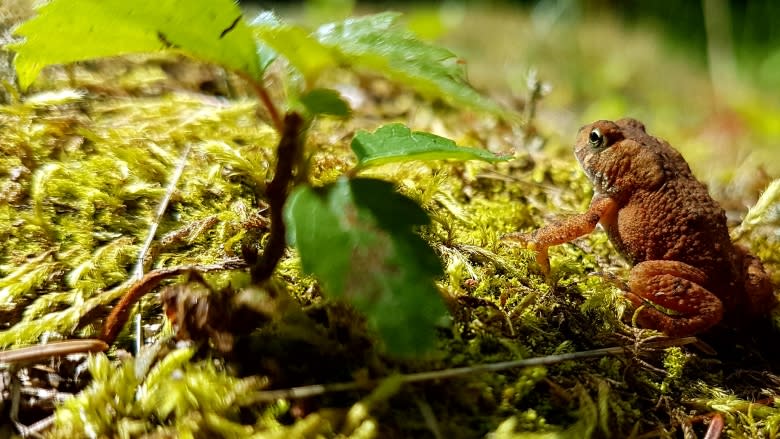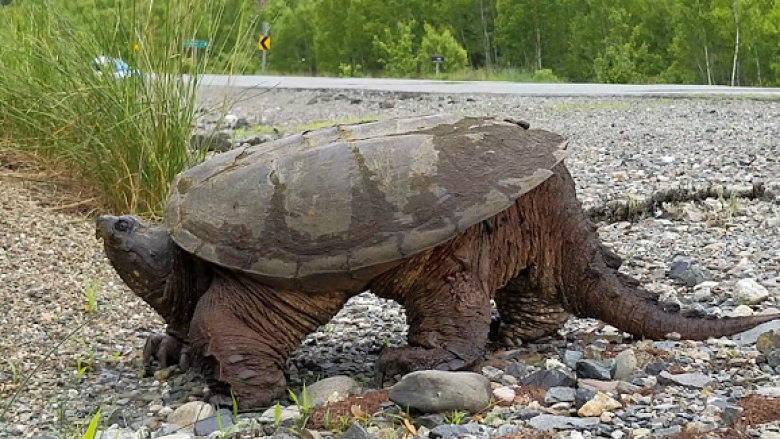Reptile and amphibian researchers meet in Manitoba in shadow of troubling report
Dozens of researchers from across the country are in Manitoba this weekend to talk about all things slithery and slimy, days after a World Wildlife Fund report suggested Canada's reptiles and amphibian numbers have plummeted by 34 per cent since 1970.
"So many of Canada's reptiles and amphibians are species at risk and facing a variety of threats," said Joe Crowley, president of the Canadian Herpetological Society and an amphibian and reptile biologist with the Ontario government.
"A majority of our reptiles and amphibians are at risk across the country."
Researchers will meet at Brandon University to discuss some of the most pressing conservation issues facing reptiles and amphibians, from highway traffic to habitat loss and climate change.
Turtles and cars
Vehicle traffic has meant turtles in some parts of Ontario are having a hard time surviving the slow, treacherous pilgrimages from their winter hibernation areas to drier upland nesting spots during spring migration season.
Most amphibian and reptile species live in the southern-most parts of the country. As humans continue to occupy more space in this prime habitat more roads are built that crisscross through the backyards of wet and wild creatures, posing an increasingly serious hazard, Crowley said.
According to Crowley, at academic conferences it's now the norm to hear several presentations on how roads are hurting reptiles and amphibians, as well as what's being done about it.
"They're constantly crossing roads," Crowly said, adding seven of eight Ontario turtle species are listed as at-risk.
Crowly added that turtles, because of their long life-histories, are particularity susceptible to slow attrition because of highways.
"Even a handful of [individual deaths] from a population can be more than enough to cause that population to be slowly declining over time."
There heve been some innovative experiments in recent years, including the installation of fencing along busy highways meant to funnel turtles toward human-made "ecopassageways." Though, ironically, some of the very fences meant to help have been found to trap turtles in the middle of the road like sitting ducks.
Climate change concerns
About a third of all Manitoba reptiles and amphibians are listed as at-risk in Manitoba.
Whereas the outlook for many endangered species outside of Manitoba is dimming as the climate warms, "Manitoba is a region of contrast," said biologist Doug Collicutt, co-ordinator of the Manitoba Herps Atlas.
Agile generalists such as chorus frogs and garter snakes can live everywhere from pristine remote parts of the boreal forest to small roadside ditches and wetlands in ares with lots of human activity, Collicutt said.
The great plains toad is considered a threatened species but Collicutt says it, too, seems in some cases to thrive in agricultural fields.
But when it comes to species more sensitive to change, like the hognose snake and Prairie skink in the southwest, things don't look so good.
Prairie skink
Following two full days of presentations, the group will head to the Spirit Sands region in Sprucewoods Provincial Park, about 190 kilometres west of Winnipeg, where they'll pay Manitoba's lone (and endangered) lizard species a visit.
Most of what's left of the stripy, olive-brown northern Prairie skink population in Manitoba resides in the Spirit Sands region, with one more small group living 85 kilometres to the west in the Lauder Sandhills Wildlife Management Area.
The Spirit Sands is one of a handful of areas in Canada with sand dunes, cacti and western hognose snakes.
Brandon University biologist Pamela Rutherford studies skinks and is one of the people leading the Monday field trip.
The hognose snake and Prairie skink rely on native mixed-grass Prairie habitats — an ecosystem that has been reduced to a fraction of what it was historically.
"You can't even call it the 'prairie region' as there is virtually no significant natural prairie left," Collicutt said. "Most prairie dependent species are in trouble, relegated to ever shrinking islands of habitat."
As is the case with other native grasslands, agricultural and farming activity have destroyed mixed-grass ecosystems.
It's possible the skink could adapt better to climate change than other reptiles and amphibians, Collicutt says, as they would've made there way into Manitoba during a period thousands of years ago when conditions were generally warmer.
Then again, climate change will likely change the temperature and moisture profile they've adapted to over the millenia.
"These organisms may be unable to move because they require the sandy soils for egg laying and hibernation. Therefore, they may be negatively impacted by climate change," said Rutherford.
Native land preservation key
She added that it's also important to keep tabs on amphibians because their health is a reflection of how aquatic habitats are doing.
"When frogs don't survive it is because of poor water quality which can directly affect water quality for humans," she said.
According to Collicutt, whatever happens in the near future to Canada's frogs, snakes, lizards and turtles, the key to preserving biodiversity is to snatch up and protect as much native habitat as possible in the present.
"Our boreal region is still in pretty good shape, the Prairies are all but gone," Collicutt said. "Herp-wise, species that are generalist in their habitat requirements ... will persist. It's those that require pristine habitats that will continue to dwindle."



